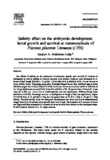Salinity effect on the embryonic development, larval growth and survival at metamorphosis of Placuna placenta Linnaeus (1758)
Share
Abstract
The effects of salinity on the embryonic development, growth, and survival of D-larvae to plantigrade as well as settling in Placuna placenta were studied. Embryos were developed to D-larvae of shell length (SL) 86±12 μm (SL±S.D.) after 20 h at salinities of 22–34 ppt, but not at lower salinity levels. Percentage production of straight-hinged larvae from fertilized eggs at these salinities ranged from 51% to 63% (P≥0.05). P. placenta larvae survived and settled in salinities of 16–34 ppt. Settlement occurred first (14 days) in salinities of 22–34 ppt and later (19 days) in 16 ppt when SL≥200 μm. Larval size at metamorphosis was not significantly different among these salinities (P≥0.05). Percentage survival of plantigrades at 34 ppt (13%) was significantly higher (P≤0.05) than at 16 ppt (4.5±3%), but not greater than at 22 (6.3±3%) or 28 ppt (7±4%) salinity. The best salinity levels for embryonic development and larval survival at metamorphosis ranged from 22 to 34 ppt and larval growth from 16 to 34 ppt. The tolerance of P. placenta to lower and higher salinities progressively increased as larvae develop from embryo to the plantigrade stage.
Suggested Citation
Madrones-Ladja, J. A. (2002). Salinity effect on the embryonic development, larval growth and survival at metamorphosis of Placuna placenta Linnaeus (1758). Aquaculture , 214(1-4), 411-418. https://doi.org/10.1016/S0044-8486(02)00401-5
Subject
Collections
- AQD Journal Articles [1248]


